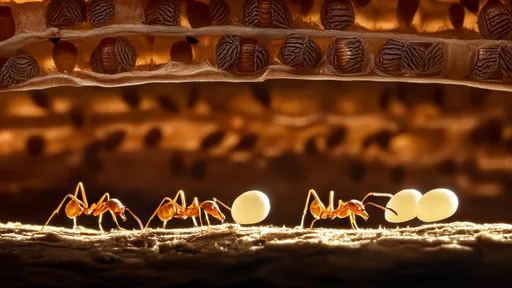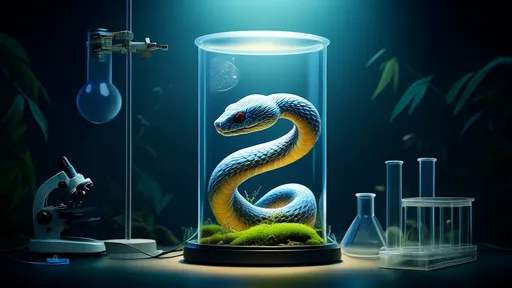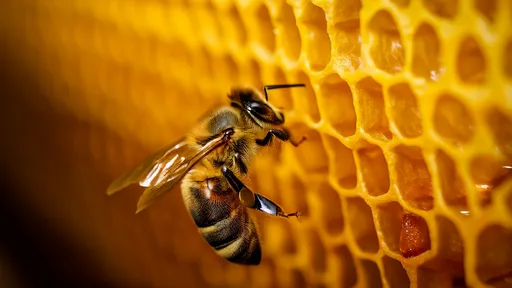The natural world is full of wonders, and few creatures captivate the human imagination quite like the chameleon. Known for its remarkable ability to change color, this enigmatic lizard has long been a subject of fascination and scientific inquiry. But what exactly enables the chameleon to alter its appearance so dramatically? The answer lies in a sophisticated interplay of biology, physics, and environmental adaptation.
At the heart of the chameleon's color-changing ability are specialized cells called chromatophores. These cells, found in the reptile's skin, contain pigments and nanocrystals that interact with light in unique ways. Unlike popular belief, the chameleon doesn't change color primarily for camouflage. Instead, these transformations serve multiple purposes, including communication, temperature regulation, and emotional expression. The process is far more complex than a simple shifting of pigments—it involves an intricate dance of cellular structures and light reflection.
The science behind this phenomenon begins with understanding the layers of the chameleon's skin. The outermost layer contains yellow and red pigments in xanthophores and erythrophores, while deeper layers house melanophores containing brown melanin. However, the most fascinating components are the iridophores—cells packed with guanine nanocrystals arranged in lattice formations. These nanocrystals reflect specific wavelengths of light depending on their spacing, which the chameleon can actively control by relaxing or exciting its skin.
When a chameleon decides to change color, its nervous system sends signals to these specialized cells. The iridophores can adjust the spacing between their nanocrystals, thereby altering which colors they reflect. By combining this structural coloration with the movement of pigments in other chromatophores, the lizard achieves its full spectrum of possible hues. This explains why a chameleon can shift from green to red so rapidly—the change isn't about producing new pigments but about reorganizing existing structures at the nanoscale.
Recent research has revealed even more depth to this biological marvel. Scientists using advanced microscopy techniques have discovered that chameleons actually have two superimposed layers of iridophores with different optical properties. The upper layer contains larger, more loosely packed guanine crystals that preferentially reflect near-infrared light, potentially helping with thermoregulation. The lower layer has smaller, more tightly arranged crystals that create the visible color changes we observe. This dual-layer system allows the chameleon to manage both its appearance and its body temperature simultaneously.
The speed and precision of these color changes are equally impressive. Unlike octopuses or cuttlefish that rely on muscular control of pigment sacs, chameleons achieve their transformations through a combination of hormonal and neural signals. This system allows for remarkably fast responses—some species can complete a full color change in as little as 20 seconds. The changes aren't just for show; they convey important information to other chameleons about dominance, mating readiness, and territorial boundaries.
Environmental factors play a crucial role in this process. While the chameleon's color-changing ability is innate, its expression depends on various external conditions. Temperature, light intensity, and even the animal's emotional state can influence the outcome. A cold chameleon, for instance, might appear darker to absorb more heat, while an agitated male facing a rival could rapidly flash bright, contrasting patterns. These responses demonstrate how the color-changing mechanism serves multiple survival functions beyond simple background matching.
Interestingly, not all chameleon species possess equal color-changing capabilities. The most dramatic transformations occur in species that inhabit diverse environments with complex social structures. Madagascar's panther chameleon, for example, exhibits some of the most vibrant color shifts in the animal kingdom. In contrast, species living in more stable environments with fewer predators or social interactions show less dramatic changes. This variation supports the idea that the color-changing ability evolved primarily for social signaling rather than camouflage.
The study of chameleon coloration has inspired numerous technological innovations. Researchers in materials science are developing synthetic structures that mimic the chameleon's nanocrystal arrays, with potential applications in adaptive camouflage, smart fabrics, and even anti-counterfeiting technologies. Military researchers particularly interested in creating surfaces that can change their infrared signature are looking closely at how chameleons manage near-infrared reflection without affecting their visible coloration.
Despite these advances, many mysteries remain about chameleon color change. Scientists still don't fully understand how the animal's brain coordinates such precise control over its nanocrystal arrays or how the system evolved in the first place. Some researchers speculate that the ability may have originated as a means of UV protection before being co-opted for communication purposes. Others suggest it could have developed from more basic temperature-regulation mechanisms found in other reptiles.
What makes the chameleon's color-changing ability truly extraordinary is its integration of multiple biological systems. It's not just about skin cells or nanocrystals—it's about how the nervous system, endocrine system, and cellular structures all work in concert to produce this visible magic. The next time you see a chameleon shift from green to red, remember that you're witnessing one of nature's most sophisticated optical displays, perfected over millions of years of evolution.
As research continues, each new discovery about chameleon coloration reveals deeper layers of complexity in this remarkable adaptation. From the quantum-level interactions of nanocrystals to the evolutionary pressures that shaped them, the science behind chameleon color change continues to challenge and inspire biologists, physicists, and engineers alike. This humble lizard's skin may hold secrets that could revolutionize how we think about color, light, and materials in the years to come.

By /Aug 4, 2025

By /Aug 4, 2025

By /Aug 4, 2025

By /Aug 4, 2025

By /Aug 4, 2025

By /Aug 4, 2025

By /Aug 4, 2025

By /Aug 4, 2025

By /Aug 4, 2025

By /Aug 4, 2025

By /Aug 1, 2025

By /Aug 1, 2025

By /Aug 1, 2025

By /Aug 1, 2025

By /Aug 1, 2025

By /Aug 1, 2025

By /Aug 1, 2025

By /Aug 1, 2025

By /Aug 1, 2025

By /Aug 1, 2025